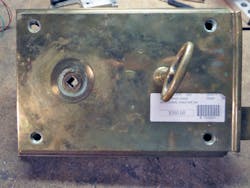Several months ago Locksmith Ledger assisted a subscriber in restoring a 100-year-old Corbin unit lock and fitting keys. Pictures and procedures were printed in Locksmith Ledger (Read online at www.locksmithledger.com/11268441). Most front door locksets made during the early 20th century had a cast iron housing and internal parts were all cast brass. With a little care, locks like this should still be running 100 years from now and will probably outlast the building they are installed in. While modern mortise locks may be more secure, one wonders if the stamped steel parts found in many mortise locks of today will continue to function for the same amount of time.
A subscriber recently sent in pictures of yet another unusual lockset and asked how to remove it from the door for servicing. By coincidence, this lock was also made by Corbin. The lock is a reproduction of a Williamsburg rim bit lock which was originally made during the 1800s. Pictures of the keyway show the keyway to be a Corbin CO7 keyway which was popular in the 1940s and 1950s. This still made the lock 60 to 70 years old.
After we forwarded e-mail removal instructions, the locksmith did successfully remove the lock and then asked if Locksmith Ledger would be interested in restoring the lock back into working order. We quickly agreed.
Our first order of business was to disassemble the cylinder. Two screws at the back of the cylinder hold the threaded portion onto the portion containing the pin tumblers. Once the cam and threaded portion were removed, it was a simple chore to shim the plug and remove it for cleaning.
A wire brush made quick work of removing dirt of the ages. There are only four tumblers in the lock which uses spaces two through five. Housing to hold the first tumbler has been milled away to allow the face of the plug to fit through the outer escutcheon. The cylinder cam had been rubbing against the turn piece in the lock, so a small amount of metal was milled off of the cam for extra clearance.
The final step was to remove every operating piece in the lock and completely clean the parts with a wire brush until they shined like the first day they were made. Photos were taken before disassembly to simplify re-assembly and to make sure that the proper handing was retained.
It may be difficult to see in the lock unit photo but the tag on the lock case shows a price tag of $350. This is probably a used door price charged by some antique shop. It appears that somebody will be having a second hand door and Williamsburg lock installed on their home and we guarantee that it will function like new for many decades to come.






